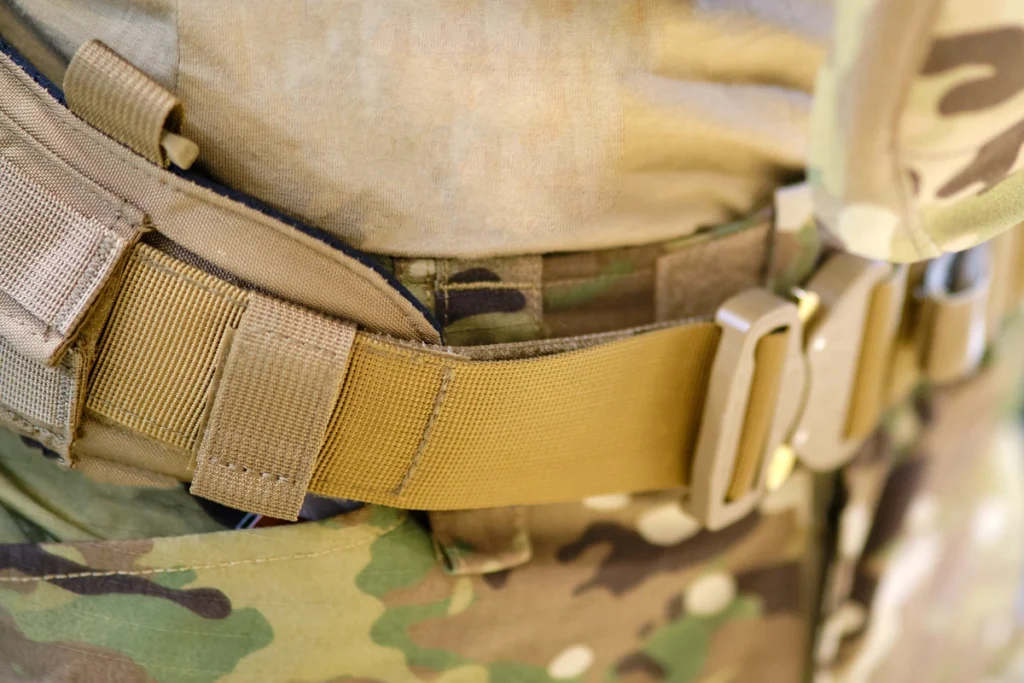Choosing the right tactical belt is crucial not only for carrying comfort, but also for the functionality of all equipment. A well-chosen tactical belt allows you to carry essential accessories comfortably, while providing quick access to them in situations that require it. An ill-fitting belt, on the other hand, can result in discomfort and even reduce your mobility.
In addition, a tactical belt is not only a piece of equipment, but also an integral part of your safety in combat situations. The belt’s reliability, durability and adaptability to changing conditions are factors that can determine success or failure in action. Therefore, it is worth taking the time to carefully select the right belt.
Types of tactical belts – what does the market offer?
The market offers a wide range of tactical belts, differing in both design and purpose. You can find belts of different widths, thicknesses, as well as the number and type of attachments. Choosing the right model depends on the specific tasks you perform. EDC (Everyday Carry) belts will work well for everyday use, providing space for basic accessories, while combat belts (battle belts) offer more space for gear, making them ideal for combat tasks.
It is also worth looking at life belts that have additional features, such as the ability to fasten quickly or to withstand extreme loads. Remember to choose a belt that best suits your needs and requirements, as well as the conditions in which you will be using it.
Material of construction – a key element of durability
The material from which a tactical belt is made directly affects its durability and strength. The most popular are belts made of nylon, which is characterized by high resistance to abrasion, stretching and weathering. Good quality nylon is lightweight, yet strong enough to withstand significant loads.
Another frequently used material is cordura, which, although heavier than nylon, offers even higher resistance to mechanical damage. Some belts can also be reinforced with additional layers or stitching, further increasing their durability. When choosing a belt, it is worth considering the conditions in which it will be used and choosing the right material to ensure maximum product life.

Wearing comfort and fitting the belt to the figure
The comfort of wearing a tactical belt is an aspect that cannot be ignored, especially if you are planning long field operations. The belt should be wide enough and soft enough not to cause chafing or pressure when worn. Belt adjustment is another important element – a good belt should allow you to easily and precisely adjust it to the circumference of your hips or waist, even if you wear it on top of your clothing.
In addition, some belts offer extra padding or cushioning, which greatly improve comfort, especially during prolonged wear. It is worth paying attention to these elements when choosing a belt to ensure maximum comfort, even in the most demanding situations.
Fastening systems – what is worth knowing?
Attachment systems are crucial to the functionality of a tactical belt. The most popular solution is the MOLLE (Modular Lightweight Load-carrying Equipment) system, which allows you to attach a variety of pockets, pouches or covers in any arrangement. Thus, the belt can be customized to suit your individual needs and the tasks you intend to perform.
Other attachment systems, such as PALS (Pouch Attachment Ladder System), also offer modular expansion of the belt. Whichever system you choose, make sure your belt allows you to attach accessories stably and securely, while still allowing you to quickly detach them when needed.
What add-ons and accessories can increase functionality?
Add-ons and accessories for tactical belts can significantly increase their functionality. The most common are pockets for magazines, small arms pouches, knife covers and first aid kits. However, it is worth remembering that the belt should not be overloaded – excess accessories can limit your mobility and carrying comfort.
Some belts also offer the option of attaching additional shoulder straps, which can help distribute weight evenly. Another useful accessory can be quick-release buckles, which allow you to quickly remove the belt in emergency situations. The choice of accessories should depend on the specific tasks you perform and your individual needs.

Price vs. quality – what to look for?
Price is often a key factor in choosing a tactical belt, but it is worth remembering that the cheapest options may not meet your expectations in terms of durability and functionality. Investing in a more expensive but better-made belt can pay dividends in terms of longer wear time and greater comfort.
When choosing, it is worth paying attention to the opinions of other users and the tests and reviews available on the web. The highest price does not always mean the best quality, but often a higher price bracket is associated with better materials and more advanced technological solutions.
How to choose the perfect belt?
In summary, choosing the right tactical belt is a process that requires thinking about many factors, such as the type of belt, material of construction, wearing comfort, attachment systems and available accessories and attachments. It is important to match the belt to your individual needs and the tasks you intend to perform. And don’t forget to consider quality versus price – a better investment can bring long-term benefits.
Ultimately, a tactical belt is not only a piece of your equipment, but also a tool that can affect your effectiveness and safety. Choose wisely to ensure that you are not only comfortable, but also confident in all conditions.



